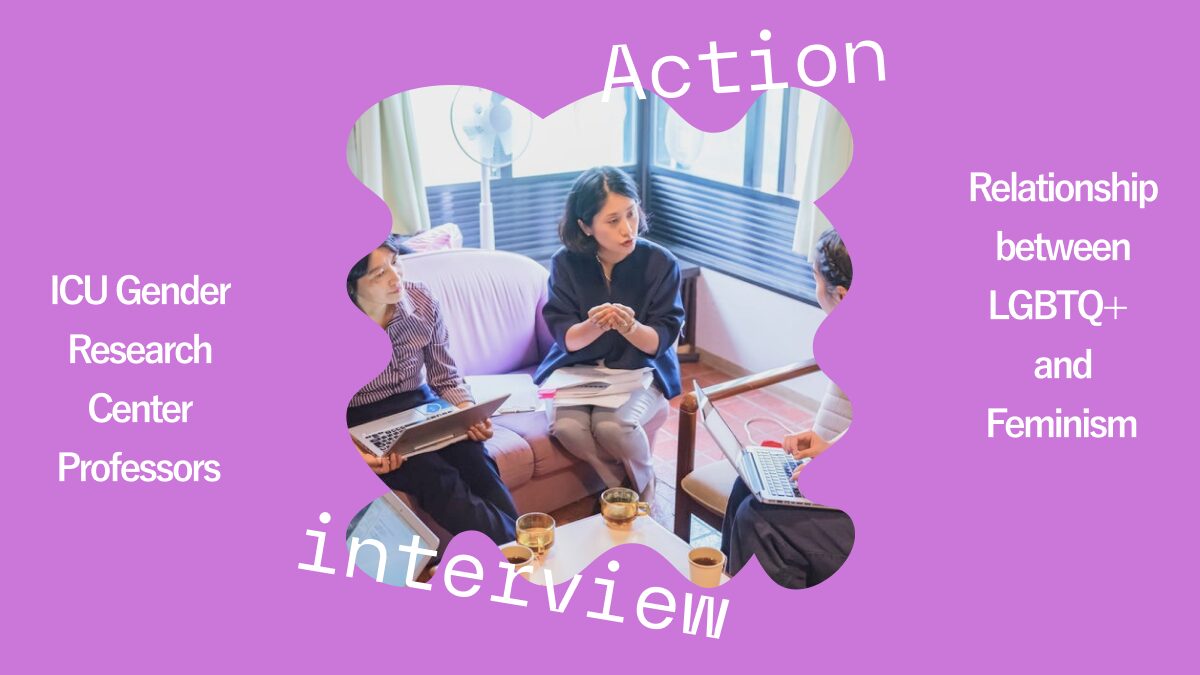【Interview】Exploring the Relationship between LGBTQ+ and Feminism with ICU Gender Research Center Professors

Feminism has been increasingly discussed in various places lately. When you hear the word “feminism,” what kind of image comes to your mind? Perhaps for LGBTQ+ individuals, feminism might be perceived as tackling only “male-female” discrimination, and some may feel it is somewhat disconnected from LGBTQ+ issues.
Both feminism and LGBTQ+ revolve around gender-related matters, but how are they connected? To address such questions, we had the opportunity to speak with Professors Takamatsu and Kato from the International Christian University (ICU) Gender Research Center.
(Interviewer: Mari Ito)
Feminism and LGBTQ+ share the same concerns
Ito: When you hear “feminism,” it’s common to imagine it as a concept where women oppose gender discrimination. I’ve heard some LGBTQ+ individuals feel like it’s somewhat unrelated to them. Both feminism and LGBTQ+ are broadly related to gender, but how exactly are they interconnected?
Takamatsu: In our society, right from birth, we are automatically categorized as either “male” or “female.” There are various systems built upon this binary division of “male” and “female,” which is a problem in itself.
Kato: In this society, certain specific aged and gendered individuals, namely older heterosexual men, take center stage. As we can see from factors like wages and employment status, the current society is structured to favor these particular men.
This societal structure is called “patriarchy.” It’s a system where specific older men control other people (young men and women) besides themselves.

Takamatsu: Patriarchy emphasizes traditional notions of “masculinity” and “femininity.” For example, within this “masculinity,” there’s a belief that men should marry women and have children.
Kato: People who have lived with these values tend to judge those who don’t fit into them as “failures,” and conversely, they might feel scared of those with different values.
Takamatsu: Feminism has been critiquing this patriarchy for a long time. And actually, this patriarchal system not only marginalizes women but also LGBTQ+ individuals.
Ito: So, patriarchy is not just a problem for feminism?
Takamatsu: That’s correct. Because this patriarchy is related to the deeply rooted “binary gender system” and “heteronormativity” in society.
Kato: In a workplace survey conducted by “Nijiiro Diversity,” in 2016, researcher Hitoshi Ishida commented on the results. It showed that the proportion of older male respondents who would feel uncomfortable if their colleagues or subordinates were LGBTQ+ was overwhelmingly high. This is a classic example of patriarchy. The same people who look down on women as “just a woman” are also the ones trying to exclude LGBTQ+ individuals.
Ito: I see…
Takamatsu: In that sense, feminism and LGBTQ+ share a common foundation in dismantling patriarchy, and I believe they stand on the same horizon. To create a society where people of all genders, sexual orientations, and gender identities can live comfortably, we need to reexamine and address these issues together.

Scary Feminism × Stylish LGBTQ+?
Ito: Many people might have a scary image of feminism, but on the other hand, LGBTQ+ is often portrayed as stylish and trendy. Can’t these two, with feminism burdened by negative perceptions and LGBTQ+ being relatively new and fashionable, come together to change society?
Kato: Recently, the term LGBTQ+ has become more widely known, but the issues it addresses are not new or recent. LGBTQ+ individuals have been oppressed and discriminated against for a long time. It’s just finally starting to gain attention and momentum in society.
Takamatsu: It’s essential that there’s momentum in the society. Still, there is a feeling of concern that it might be seen just as a fleeting trend.
Ito: Why is that?
Takamatsu: Because this is a matter of critical “human rights” that involve lives and livelihoods.
Kato: As seen in the survey results I mentioned earlier, LGBTQ+ individuals are more interested in pressing matters like healthcare and finance rather than fashion and other fields when asked about their interest in LGBTQ+-friendly products.
Takamatsu: We must not forget that LGBTQ+ is fundamentally about human rights. Regardless of the buzz, constant discussions are necessary for a society where the dignity of every individual is protected.
Ito: So, the trendy and new image might overshadow the essential points.
Takamatsu: Exactly. For instance, if people only know the term LGBTQ+ without understanding the specific issues they face, they won’t focus on concrete problems like healthcare. Moreover, they won’t question societal norms based on binary gender.
Kato: The critical issues concerning survival, living with a partner, welfare and caregiving, are often overlooked in a society that strongly emphasizes heteronormativity. There seems to be a significant gap between those trying to commodify the glamorous aspects of the “LGBT market” to stimulate the economy and the actual LGBTQ+ individuals. Having a beautiful wedding and wearing stylish clothes is not enough to ensure a secure and comfortable life.

Ito: So, I think if we can collaborate effectively, taking into account the step-by-step nature of feminism, like the experiences of its struggles in various areas of society, we might be able to make positive changes in society.
Takamatsu: There’s a possibility for that. After the trend passes, what will happen next? We should think about creating mechanisms that respect diversity in all fields, not just in areas that are easy to adopt.
Ito: Feminism itself is also evolving, isn’t it? Recently, fashionable and cool feminist icons are appearing more and more.
Kato: Feminism has also gone through various waves to reach where it is today. In the past, if you wore makeup, you sometimes faced criticism like “Are you trying to please men?” even from within your own group. But now, there’s a new wave where feminists can wear high heels and makeup, embracing the idea that it’s okay!! I feel that the atmosphere and image of feminism have changed quite a bit from the 70s.ber 16, 2018.
Ito: Both feminism and LGBTQ+ have diverse expressions, and I think it’s a good thing that you can explore what fits you best within that diversity.
Becoming Sensitive to Exclusion
Ito: I’ve heard about the history of feminism itself excluding lesbian women and the divisions that occurred within the LGBTQ+ pride movement. Recently, when Ochanomizu Women’s University decided to accept transgender women, some women expressed concerns.
Takamatsu: I haven’t personally met any “feminists” who oppose Ochanomizu Women’s University’s decision, but if such a thing happens, it’s a problem, in my opinion.
Kato: Originally, women’s Universities were established to provide educational opportunities for talented women who couldn’t study with male students. If we end up excluding transgender women, it would be the same kind of exclusion we faced in the past, and that doesn’t seem right.
Ito: How can we make the movement more inclusive to everyone?
Takamatsu: I believe having imagination is important. It’s the ability to imagine that people living in different bodies and environments might be having different experiences from our own. And in our activities, we should always self-reflect to ensure we’re not excluding anyone or creating power dynamics.
Ito: So you are saying that, by constantly having empathy for others and imagining their perspectives, we can discuss differences of opinion and understand where they come from.
Takamatsu: Yes. Even though LGBTQ+ individuals and feminists who are not part of that community may face different specific problems, we can still discuss and criticize the strongly ingrained binary gender and heteronormativity in society together. The issues are shareable regardless of our standpoints.
LGBTQ+ individuals and feminism. Although their positions, ways of life, and the challenges they face may seem different at first glance, it has become evident that there are common underlying issues that contribute to the difficulties they experience. To create a society where everyone can live comfortably, we think that it’s essential to transcend these differences and share our experiences, learn from each other’s strengths, and collectively examine the way society functions.
(Photography: Yasuharu Hoshino, Translation: Jennifer Martin)
This article is a modified repost of the original article released on the web media “Palette” on October 16, 2018.
